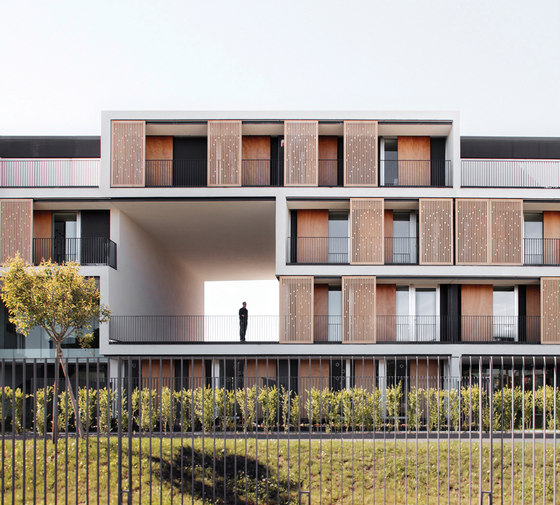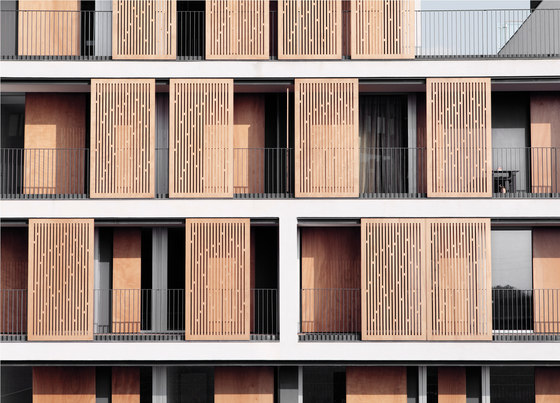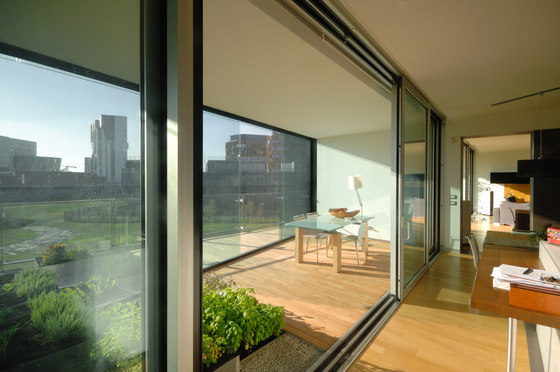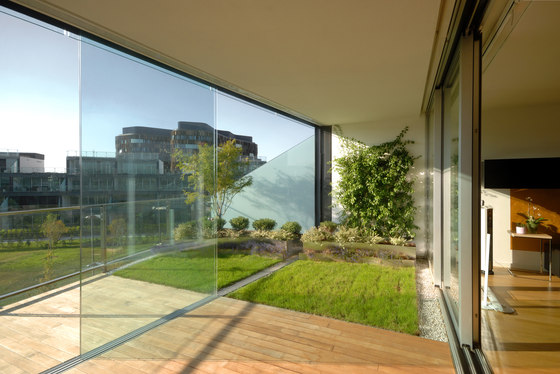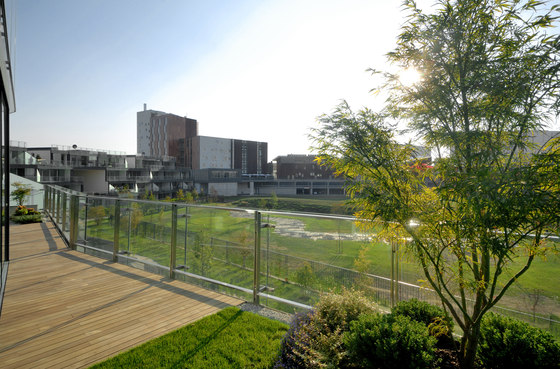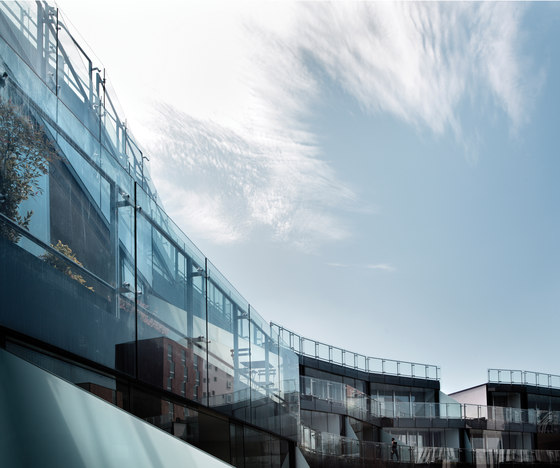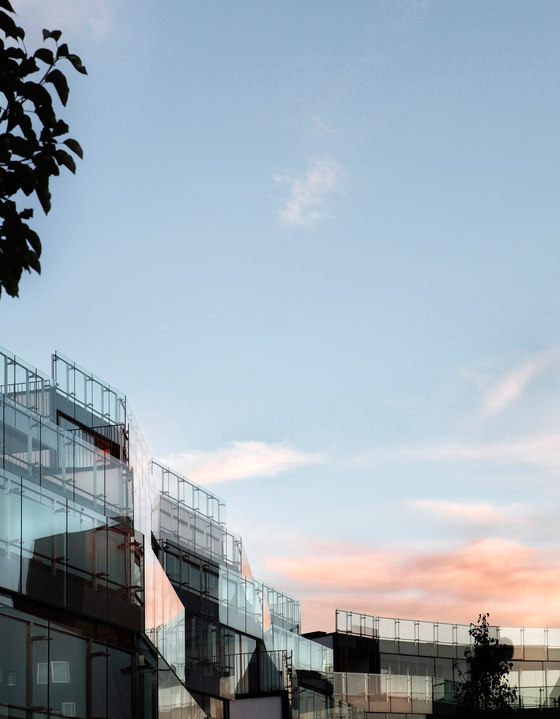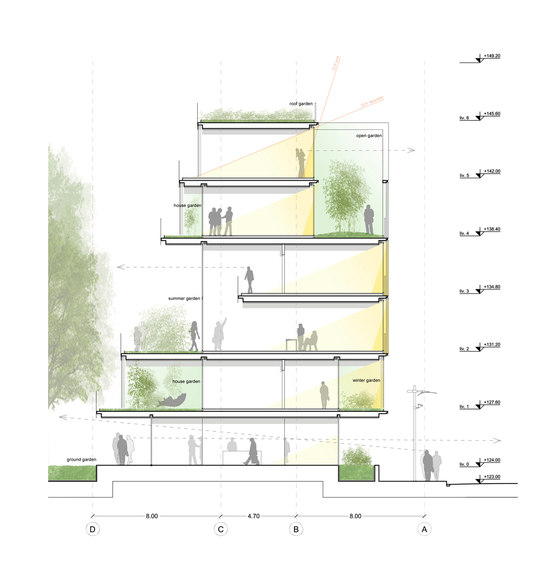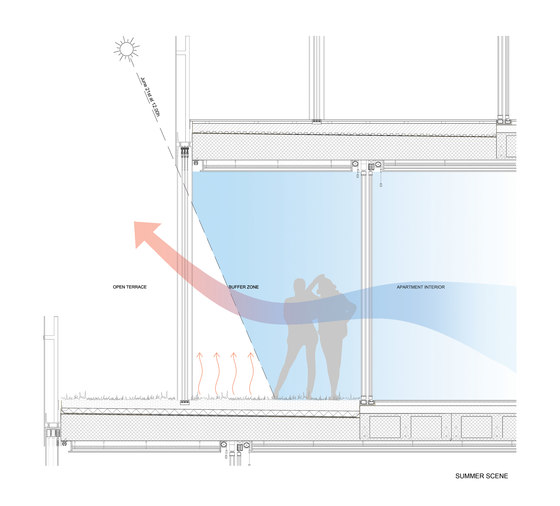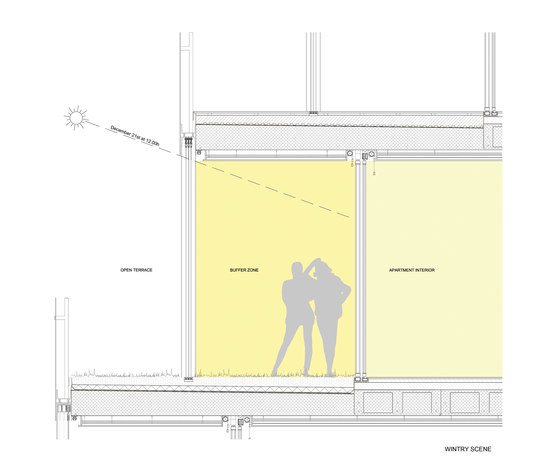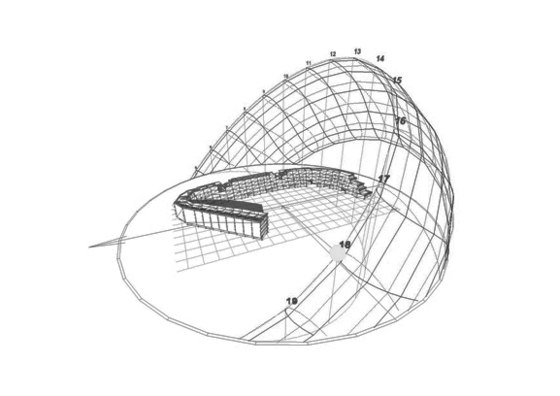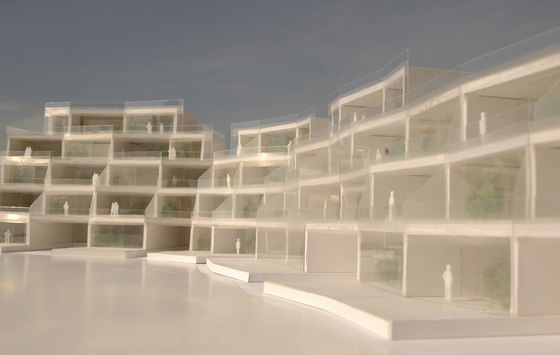The Masterplan of Milanofiori is characterized by a series of functions (offices, hotels, restaurants, cinemas, leisure, residences) that define together a cluster whose elements appear to follow the characteristics of the surrounding landscape creating a public park as the extension of the existing forest. The design of the Residential Complex seeks the symbiosis between architecture and landscape, so that the synthesis of artificial and natural elements could define the quality of living and the sense of belonging by the inhabitants.
The interface between the building and the garden becomes the field where interaction between man and environment takes place. This interface is defined by the "C" form of the complex which encompasses the public park, and by the porosity from interior to exterior that characterizes all 107 apartments.
The two facades are designed differently: the one facing the street outside is more urban, and the one towards the inner park is more organic. The design of the urban facade stimulates a sense of belonging thanks to the composition of white frames which identify separately the units. These frames include vertical wooden panels of different widths which can slide across the frames and control the inner light as necessary. The organic facade overlooking the garden features double glazed bioclimatic greenhouses. The co-planarity between the glass of the greenhouse and the glass guardrail covering the string-course creates an effect where the shape of the construction and the background merge and reverse their roles constantly, producing kaleidoscopic effects overlapping the reflection of the public garden outside with the transparency of the private garden inside.
The geometry of the building is shaped by translation of the upper levels in line with positions of optimum solar exposure and by tapering of the external terraces in order to increase introspection among residents.
The winter garden has a double value: an environmental value in providing a buffer zone which allows thermal regulation, and an architectural value in allowing extension of the interior living space towards the exterior landscape (and vice versa) permitting different uses from summer to winter. Through the overlap of different natural layers (the public park, the open terraces and the winter gardens) the project seeks a kind of a holism of nature, where various personal interactions of these natural layers create an intensive landscape that is directly and personally customized by each resident.
In line with ever changing developments in contemporary living, the porosity of the architecture makes Milanofiori residential complex an evolving organism, in perpetual change, preferring the dynamic exchange between architecture and nature and stimulating the interaction between man and environment.
The Milanofiori project investigates new ways of contemporary living by developing three themes.
Nomadism and sedentary. Contemporary life brings each of us to live a house as a place where you come from and where you come back to, in a continuous alternation of time and space.
This means that sedentary and nomadic attitude coexists in our everyday living experience. To express this duality it is not enough to think just in terms of housing types that meet the most varied requirements of all possible users. It is needed instead a paradigm shift that lies in reversing the direction of the discussion: from the house as an object to the inhabitant as the subject.
Living in the garden. Breaking free from the presence of the hypertrophic "house", the dwelling is thought more as the expression of the site as a whole, rather than a physical place. This is not simply blurring the distinction between inside / outside, but finding the continuum in which space and time are unified in one entity that cannot be separated. To do this we need to think of an opportunity: the garden. In the garden space and time are unified, they become continuous, recovering - evoking - the essential meaning of living in the sense of "taking care".
From collective complex to "polyvalent-interconnected system”. The project involves a series of open spaces for social interaction in synergy with other parts of the cluster. In this sense, the typical user lives an "interconnected life", with multiple possibilities of movement even within the same cluster. We try to overcome the concept of "Unity" (d'Habitation) in favour of a polyvalent system that overcomes the typical nuclear family separation between housing and workplace imposed by the industrial civilization, towards new models of mutual relations, trade and transversality.
Awards:
2010 European 40 Under 40, Madrid
2011 Leaf Award for the Residential Building of the Year, London
2011 Overall Winner Leaf Awards, London
2012 WAN Awards Residential, London
Client:
Milanofiori 2000 S.r.l. (Brioschi Sviluppo Immobiliare Group)
Contractor:
Marcora S.p.A. – Cile S.p.A.
Paolo Brescia e Tommaso Principi
Chiara Pongiglione
Francois Doria
Michele Renzini
Andrea Casetto
Laura Anichini
Silvia Becchi
Antonio Bergamasco
Paolo Caratozzolo Nota
Giulia D’Ettorre
Julissa Gutarra
Leonardo Mader
Elena Mazzocco
Margherita Menardo
Paolo Salami
Izabela Sobieraj
Paula Vier
Francesco Vinci
Fabio Valido
Barbara Zuccarello
Project team:
OBR S.r.l.
Favero & Milan Ingegneria S.p.A.
Studio Ti S.r.l.
Buro Happold Ltd
Davide Simonetti
Site surveyor:
Favero & Milan Ingegneria S.p.A.
Alessandro Bonaventura
Project management:
P&P S.r.l.
Luigi Pezzoli


